How To Find The Blown Bulb In Christmas Lights
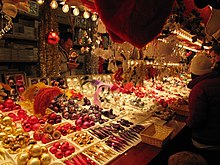

Christmas tree lights and Christmas bulb.

Christmas ornaments, baubles, "Christmas bulbs" or "Christmas bubbling" are decoration items, usually to decorate Christmas trees. These decorations may be woven, diddled (glass or plastic), molded (ceramic or metal), carved from wood or expanded polystyrene, or made by other techniques.
Ornaments are available in a diversity of geometric shapes and image depictions. Ornaments are almost ever reused year after year rather than purchased annually, and family collections often incorporate a combination of commercially produced ornaments and decorations created by family members. Such collections are oft passed on and augmented from generation to generation. Festive figures and images are commonly chosen.
Lucretia P. Hale'south story "The Peterkins' Christmas-Tree"[1] offers a curt catalog of the sorts of ornaments used in the 1870s:
There was every kind of gilt hanging-thing, from gilded pea-pods to butterflies on springs. In that location were shining flags and lanterns, and bird-cages, and nests with birds sitting on them, baskets of fruit, aureate apples, and bunches of grapes.
The modernistic-solar day mold-blown colored glass Christmas ornament was invented in the small German town of Lauscha in the mid-16th century.[2]
History [edit]
Invention [edit]
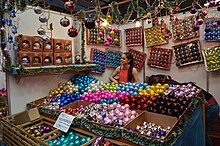
Blown drinking glass baubles for auction in Tlalpujahua, Michoacán, Mexico. The town is known for its product of Christmas ornaments. [iii]

A fully decorated Christmas tree
The kickoff decorated trees were adorned with apples, white processed canes, and pastries in the shapes of stars, hearts and flowers. Glass baubles were first made in Lauscha, Germany, by Hans Greiner (1550–1609), who produced garlands of glass beads and tin can figures that could exist hung on trees. The popularity of these decorations grew into the production of glass figures made by highly skilled artisans with clay molds.
The artisans heated a glass tube over a flame, and then inserted the tube into a dirt mold, blowing the heated glass to expand into the shape of the mold. The original ornaments were only in the shape of fruits and nuts.
Later on the glass cooled, a silverish nitrate solution was swirled into it, a silvering technique adult in the 1850s by Justus von Liebig. After the nitrate solution dried, the ornamentation was hand-painted and topped with a cap and hook.[4]
Export [edit]
Other glassblowers in Lauscha recognised the growing popularity of Christmas baubles and began producing them in a wide range of designs. Soon, the whole of Deutschland began ownership Christmas glassware from Lauscha. On Christmas Eve 1832, a young Victoria wrote about her delight at having a tree, hung with lights, ornaments, and presents placed round it.[5] In the 1840s, afterward a picture of Victoria's Christmas tree was shown in a London paper decorated with glass ornaments and baubles from her husband Prince Albert's native Germany, Lauscha began exporting its products throughout Europe.
In the 1880s, American F. West. Woolworth discovered Lauscha's baubles during a visit to Germany. He fabricated a fortune by importing the German drinking glass ornaments to the United States.
Mass product [edit]
The first American-made glass ornaments were created by William DeMuth in New York in 1870. In 1880, Woolworth'due south began selling Lauscha drinking glass ornaments. Other stores began selling Christmas ornaments by the belatedly 19th century and by 1910, Woolworth'south had gone national with over g stores bringing Christmas ornaments beyond America. New suppliers popped up everywhere including Dresden die-cut fiberboard ornaments which were pop among families with modest children.
Past the 20th century, Woolworth'due south had imported 200,000 ornaments and topped $25 one thousand thousand in sales from Christmas decorations lone. Every bit of 2009, the Christmas decoration industry ranks 2nd to gifts in seasonal sales.[4]
Many silver companies, such equally Gorham, Wallace, Towle, Lunt and Reed & Barton, began manufacturing silver Christmas ornaments in 1970 and 1971.[6]
In 1973, Hallmark Cards started manufacturing Christmas ornaments. The first collection included 18 ornaments, including six glass brawl ornaments.[seven] The Hallmark Keepsake Decoration collection is dated and available for only one year. By 1998, 11 million American households collected Hallmark ornaments, and 250,000 people were member of the Emblem Ornamentation Collector'southward Club.[8] There were as many equally 400 local Emblem Ornament Collector's Club chapters in the United states of america.[9] One noted Christmas ornament say-so is Clara Johnson Scroggins who has written extensively on the topic and has i of the largest private collections of Christmas ornaments.[10]
In 1996, the ornament industry generated $two.4 billion in total annual sales, an increment of 25% over the previous yr. Industry experts estimated more than than 22 meg United states of america households collected Christmas ornaments, and that 75% of those households collected Hallmark Emblem Ornaments.[xi]
Mail World War II [edit]

After Globe War II, the East German government turned most of Lauscha's glassworks into state-endemic entities, and production of baubles in Lauscha ceased. After the Berlin Wall came downward, most of the firms were reestablished as private companies. As of 2009, there are still about 20 modest drinking glass-blowing firms agile in Lauscha that produce baubles. One of the producers is Krebs Glas Lauscha, office of the Krebs family which is now one of the largest producers of glass ornaments worldwide.
Modern baubles [edit]
Although glass baubles are however produced, equally expensive skilful-quality ornaments oftentimes institute at markets, baubles are now frequently fabricated from plastic and available worldwide in a huge variety of shapes, colors and designs. At that place are a large number of manufacturers producing sophisticated Christmas glass ornaments in Poland, which produce "bombka" or the plural form "bombki"; and millions of glass-blown Christmas ornaments are fabricated year-round in Tlalpujahua, Michoacan, United mexican states, and exported to Spain, New Zealand and France. They are also made in Chignahuapan, Puebla, United mexican states.[12]
Handcrafted [edit]
Handcrafted Christmas ornaments have become a staple of craft fairs and many smaller online businesses owe much of the success to both the cyberspace and the growth of arts and crafts stores. Saccharide cookies, popcorn balls, gingerbread and many types of cookies tin can be used as ornaments.[13]
Manufacture of handmade drinking glass ornaments [edit]
-

Design of a drinking glass Christmas ornamentation
-

Sculpturing to produce a mould for a Christmas glass ornament
-

Blowing drinking glass ornament fabrication
-

Silvering of drinking glass ornaments
-

Painting of a glass Christmas ornament
Types [edit]
- Christmas tree ornaments
-
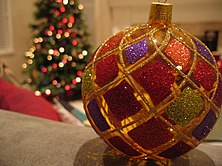
Bauble, or ball decoration
-

Blue glass ornamentation
-
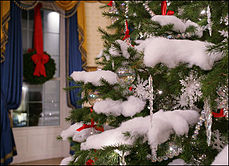
Simulated tree snow
-
Glass snowman decoration
-
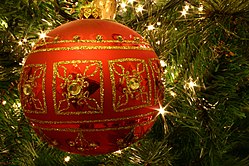
Reddish and gilt ornamented bauble
-

Angel decoration
-
Glass Fabergé egg as a decoration.
-

Deport ornament
-

Harbinger ornaments
-

-

Cloth ornament
-
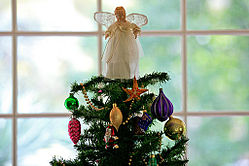
Affections as tree top ornamentation
-
Pre-1939 Polish snowman decoration
-
Drinking glass owl ornament
-

Paw-painted drinking glass bauble
-

Tinsel and glass bauble
-

Polish bombki baubles made with the kanzashi method
Encounter likewise [edit]
- Christmas tree
- Pleated Christmas hearts
- Snow baby
- Tree-topper
- Witch ball
References [edit]
- ^ Lucretia P. Unhurt, The Peterkin Papers. 1960; Houghton Mifflin
- ^ "Learning and Instruction High german". Retrieved 21 Dec 2017.
- ^ "Soplos de vidrio". National Geographic en Español. Retrieved 15 December 2016.
En la actualidad hay cerca de 200 talleres que elaboran al año más de 100 millones de piezas.
- ^ a b Ace Collins Stories Backside the Peachy Traditions of Christmas. 2003; Zondervan.
- ^ The girlhood of Queen Victoria: a selection from Her Majesty's diaries. p.61. Longmans, Greenish & co., 1912. University of Wisconsin
- ^ Robinson, Ruth (12 December 1982). "DATED ORNAMENTS ON COLLECTORS' LIST". New York Times . Retrieved 15 September 2018.
- ^ Andersen, Erin (21 December 1998). "Lincoln Journal Star at Newspapers.com". Newspapers.com . Retrieved 15 September 2018.
- ^ Andersen, Erin (21 December 1998). "Lincoln Journal Star at Newspapers.com". Newspapers.com. No. page 17. Retrieved 15 September 2018.
- ^ Barrs, Jennifer (23 July 1998). "Collecting Memories: Ornament collectors begin the chase early". The Tampa Tribune at Newspapers.com . Retrieved 15 September 2018.
- ^ Lignitz, Amy (fifteen December 1994). "Decorating the Christmas Tree is Big Concern". The Los Angeles Times. p. 10.
- ^ Jones, John Philip (1999). "The Case for Collectible Brands by January Southward. Slater". How to use advertising to build strong brands. SAGE. p. 259. ISBN9781452231396. OCLC 894769418.
- ^ "Admire the skill of the hands of Tlalpujahua". Visit Mexico. Retrieved 12 December 2018.
- ^ "Homemade ornaments for the family Christmas tree". 4 Dec 1985. Retrieved four August 2020.
External links [edit]
-
 Media related to Christmas tree ornaments at Wikimedia Commons
Media related to Christmas tree ornaments at Wikimedia Commons
Source: https://en.wikipedia.org/wiki/Christmas_ornament
Posted by: brownspoks1979.blogspot.com






0 Response to "How To Find The Blown Bulb In Christmas Lights"
Post a Comment